英语教案范文全英文版高中
- 格式:doc
- 大小:24.00 KB
- 文档页数:5
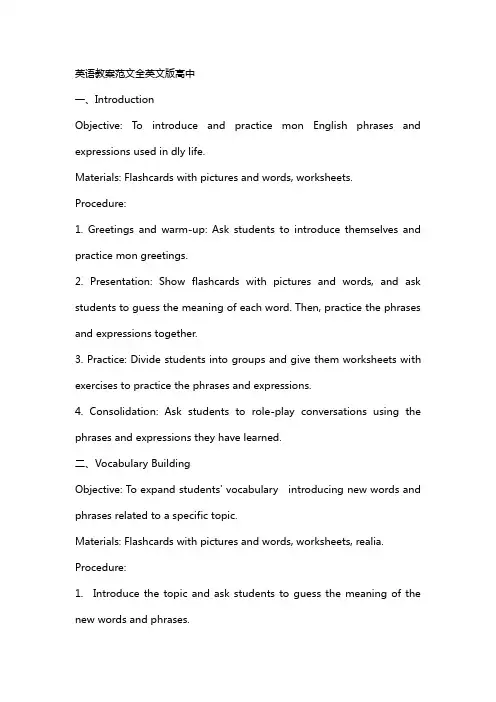
英语教案范文全英文版高中一、IntroductionObjective: To introduce and practice mon English phrases and expressions used in dly life.Materials: Flashcards with pictures and words, worksheets. Procedure:1. Greetings and warm-up: Ask students to introduce themselves and practice mon greetings.2. Presentation: Show flashcards with pictures and words, and ask students to guess the meaning of each word. Then, practice the phrases and expressions together.3. Practice: Divide students into groups and give them worksheets with exercises to practice the phrases and expressions.4. Consolidation: Ask students to role-play conversations using the phrases and expressions they have learned.二、Vocabulary BuildingObjective: To expand students' vocabulary introducing new words and phrases related to a specific topic.Materials: Flashcards with pictures and words, worksheets, realia. Procedure:1. Introduce the topic and ask students to guess the meaning of the new words and phrases.2. Presentation: Show flashcards with pictures and words, and ask students to match the words with their meanings. Then, practice the words and phrases together.3. Practice: Give students worksheets with exercises to practice the new words and phrases.4. Consolidation: Ask students to create sentences using the new words and phrases, and present them to the class.三、Listening and SpeakingObjective: To improve students' listening and speaking skills practicing dialogues and conversations.Materials: Audio recording, worksheets.Procedure:1. Ask students to listen to an audio recording and answer some questions about it.2. Presentation: Play the audio recording and ask students to repeat after the speaker. Then, practice the dialogues and conversations together.3. Practice: Divide students into prs or groups and give them worksheets with exercises to practice the dialogues and conversations.4. Consolidation: Ask students to role-play the dialogues and conversations with a partner or group, and then present them to the class.四、Reading and WritingObjective: To improve students' reading and writing skills analyzing and summarizing a text.Materials: Text, worksheets.Procedure:1. Ask students to read a text and answer some questions about it.2. Presentation: Discuss the text with students, and ask them to identify the mn ideas and supporting detls. Then, practice summarizing the text together.3. Practice: Give students worksheets with exercises to practice reading and writing skills, such as fill in the blanks, true or false, and matching.4. Consolidation: Ask students to write a summary of the text, and then present it to the class.五、Grammar ReviewObjective: To review and practice a specific grammar point. Materials: Worksheets, realia.Procedure:1. Review the grammar point and ask students to identify examples of the grammar rule in a text.2. Presentation: Expln the grammar rule and give students examples to practice. Then, practice the grammar point together.3. Practice: Give students worksheets with exercises to practice the grammar point.4. Consolidation: Ask students to create sentences using the grammar point, and present them to the class.六、Grammar FocusObjective: To focus on a specific grammar point and practice it through various activities.Materials: Worksheets, realia, flashcards.Procedure:1. Introduce the grammar point and ask students to identify examples in a given text.2. Presentation: Expln the grammar rule using flashcards, realia, and examples. Practice the grammar point together.3. Practice: Divide students into prs or groups and give them worksheets with exercises focusing on the grammar point.4. Consolidation: Ask students to create sentences using the grammar point in a real-life context and present them to the class.七、Listening ComprehensionObjective: To improve students' listening prehension skills understanding and interpreting audio materials.Materials: Audio recording, worksheets.Procedure:1. Ask students to listen to an audio recording and answer some pre-listening questions.2. Presentation: Play the audio recording and ask students to take notes. Discuss the content and answer prehension questions.3. Practice: Give students worksheets with exercises based on the audio recording, such as multiple choice, true or false, and fill in the blanks.4. Consolidation: Ask students to summarize the audio recording in their own words and present it to the class.八、Speaking SkillsObjective: To enhance students' speaking skills through discussions, presentations, and role-plays.Materials: Worksheets, realia, flashcards.Procedure:1. Introduce the topic and ask students to express their opinions on the subject.2. Presentation: Provide students with prompts or questions related to the topic and facilitate a class discussion.3. Practice: Divide students into prs or groups and give them worksheets with speaking activities, such as role-plays and presentations.4. Consolidation: Ask students to present their speaking activities to the class and provide feedback on each other's performances.九、Writing SkillsObjective: To develop students' writing skills pleting different types of writing tasks.Materials: Worksheets, realia, writing prompts.Procedure:1. Introduce the writing task and provide students with a prompt or topic.2. Presentation: Expln the writing process and provide examples of the desired writing style. Guide students through the writing process.3. Practice: Give students worksheets with writing exercises, such as essays, reports, or letters.4. Consolidation: Ask students to share their written pieces with the class and provide feedback on each other's work.十、Cultural AwarenessObjective: To enhance students' cultural awareness and understanding through the study of English-speaking cultures.Materials: Worksheets, realia, audio recordings, videos.Procedure:1. Introduce the cultural topic and ask students to share their prior knowledge.2. Presentation: Provide information about the cultural topic using audio recordings, videos, realia, and worksheets. Discuss and pare the cultural aspects with students' own culture.3. Practice: Give students worksheets with activities related to the cultural topic, such as crossword puzzles, quizzes, or short essays.4. Consolidation: Ask students to reflect on the cultural topic and share their thoughts and experiences. Encourage a class discussion and promote cultural exchange.十一、Project WorkObjective: To apply the knowledge and skills learned in previous lessons to a group project.Materials: Project materials, worksheets.Procedure:1. Introduce the project topic and expln the objectives. Divide students into groups.2. Presentation: Provide guidelines and instructions for the project. brnstorm ideas and give examples.3. Practice: Allow students to work on their projects, providing support and guidance as needed.4. Consolidation: Ask students to present their projects to the class and provide feedback on each other's work.十二、Exam PreparationObjective: To prepare students for an uping exam reviewing key concepts and practicing exam questions.Materials: Exam review worksheets, past exam papers.Procedure:1. Expln the purpose of the lesson and review the exam format.2. Presentation: Go over key concepts and provide examples. Discuss exam strategies and tips.3. Practice: Give students exam review worksheets or past exam papers to practice.4. Consolidation: Conduct a mock exam or review session, allowing students to ask questions and clarify doubts.十三、Error CorrectionObjective: To help students identify and correct mon errors in their writing.Materials: Sample student essays, error correction worksheets. Procedure:1. Expln the importance of error correction and its role in improving writing skills.2. Presentation: Provide students with sample student essays contning mon errors. Discuss the errors and their corrections.3. Practice: Give students error correction worksheets to identify and correct errors in sample sentences or paragraphs.4. Consolidation: Encourage students to peer-edit each other's writing and provide feedback on errors.十四、Extension ActivitiesObjective: To provide additional practice and challenge for students who need further development.Materials: Extension worksheets, online resources.Procedure:1. Expln that these activities are optional and designed for students who want extra practice or a challenge.2. Presentation: Provide an overview of the extension activities and expln how to plete them.3. Practice: Allow students to work on the extension activities at their own pace, providing support as needed.4. Consolidation: Encourage students to share their pleted extension activities with the class and discuss their experiences.十五、Classroom Management and ReviewObjective: To review the lessons learned and evaluate student progress. Materials: Progress charts, self-assessment worksheets.Procedure:1. Ask students to reflect on what they have learned and their progress in the course.2. Presentation: Review key concepts, vocabulary, and skills covered in the course. Discuss any challenges or areas for improvement.3. Practice: Give students self-assessment worksheets to evaluate their own progress and identify areas they want to focus on.4. Consolidation: Conduct a class review session, allowing students to ask questions and clarify doubts. Discuss strategies for ongoingimprovement and provide feedback on student progress.重点和难点解析本文主要介绍了一篇高中英语教案范例,涵盖了从问候、词汇学习、听力与口语、阅读与写作、语法复习到项目工作、考试准备、错误纠正、拓展活动、课堂管理与复习等多个方面的教学内容。

高中英语教案英文版5篇高中英语教案英文版5篇教案可以恰当地选择和运用教学方法,调动学生学习的积极性,面向大多数学生,同时注意培养优秀生和提高后进生,使全体学生都得到发展。
以下是带来的内容,感谢您的阅读,希望能帮助到您!高中英语教案英文版1Teaching Procedures of Period 1:Step1.Warming up (15 mins)Ss know a lot about sports from everyday life and media, so I arrange sucha task -discussion(group of 4): Q: What do you know about sports?During this process, if Ss can’t express themselves in English, Chinese isalso all right. Besides, it is agood chance to present new words. If necessary, I will make somecomplements. At the same time, I will present them as many pictures about sportsas possible.Possible response:school sports meetSports meet the National Gamesthe Asian Gamesthe Olympic Gamesthe World Cupetcball games: volleyball, basket ball, football, table tennis, tennis,,golfbadminton, bowling, baseball, American football, ice hockey etcEvents of sports track and field: relay race, long jump, high jump, polejump, discus, shot, javelin etcgymnastic: rings, double bars, high and low bars, horse , free exerciseswimming/shooting/skiing/ ice sports/diving/aquatic sports etcSport stars : Beckham, Mike Owen, Michael Jordan etc Purpose: This activity is designed to encourage students to think aboutsports and activaterelevant vocabulary.Step 2. Speaking(15 mins)Task1(pair work): Talk about their favourite sports, favourite sportsstars, and the reason why they like them, with the following expressions as aguide.(See SB p52) Task2(pair work): A survey about physical fitness (Seepostscript 1)Task3(group work): Add up their total scores and divide by the number ofpeople. Then get their group’s average scores. Discuss their survey answers.1). Do you think your group is doing well or not? Why ?2). How can you become fitter?高中英语教案英文版2教学目标Teaching aims and demands本单元的教学目标是使学生掌握表示判断和个人看法的常用语句,学会使用现在完成时的被动语态。
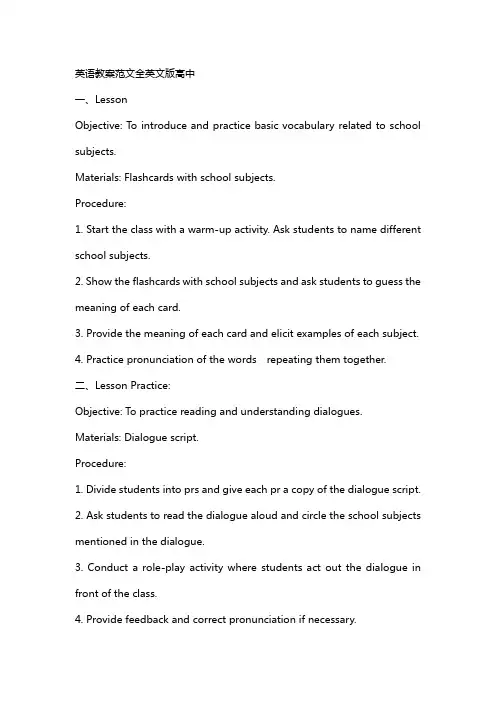
英语教案范文全英文版高中一、LessonObjective: To introduce and practice basic vocabulary related to school subjects.Materials: Flashcards with school subjects.Procedure:1. Start the class with a warm-up activity. Ask students to name different school subjects.2. Show the flashcards with school subjects and ask students to guess the meaning of each card.3. Provide the meaning of each card and elicit examples of each subject.4. Practice pronunciation of the words repeating them together.二、Lesson Practice:Objective: To practice reading and understanding dialogues. Materials: Dialogue script.Procedure:1. Divide students into prs and give each pr a copy of the dialogue script.2. Ask students to read the dialogue aloud and circle the school subjects mentioned in the dialogue.3. Conduct a role-play activity where students act out the dialogue in front of the class.4. Provide feedback and correct pronunciation if necessary.三、Lesson Extension:Objective: To enhance vocabulary skills through a fun activity. Materials: School subjects flashcards, stickers.Procedure:1. Divide students into groups and give each group a set of school subjects flashcards.2. Instruct each group to create a sentence using one of the vocabulary words from the flashcard.3. Encourage students to use the vocabulary words correctly and provide examples if needed.4. Provide positive feedback and reward each group with a sticker for their effort.四、Lesson Review:Objective: To review and assess students' understanding of the lesson. Materials: Review worksheet.Procedure:1. Distribute the review worksheet to students and expln that they will have 10 minutes to plete it.2. Monitor students' progress and provide assistance if needed.3. Collect the worksheets and assess students' understanding of the lesson.五、Lesson Wrap-up:Objective: To summarize the key points of the lesson and reinforce learning.Materials: None.Procedure:1. Summarize the key points of the lesson, emphasizing the importance of school subjects.2. Encourage students to practice using the vocabulary words in their dly lives.3. Assign a homework task related to the lesson, such as creating a sentence using one of the vocabulary words.4. Thank students for their participation and conclude the lesson.六、LessonObjective: To introduce and practice verb tenses.Materials: Flashcards with different verb tenses.Procedure:1. Start the class with a warm-up activity. Ask students to name different verb tenses.2. Show the flashcards with different verb tenses and ask students to guess the meaning of each card.3. Provide the meaning of each card and elicit examples of each tense.4. Practice pronunciation of the tenses repeating them together.七、Lesson Practice:Objective: To practice writing sentences in different verb tenses. Materials: Handout with sentence frames.Procedure:1. Distribute the handout with sentence frames to students.2. Instruct students to fill in the blank spaces with the correct verb tense.3. Provide examples and expln the rules for using each verb tense.4. Encourage students to practice writing sentences in different verb tenses.八、Lesson Extension:Objective: To enhance writing skills through a collaborative activity. Materials: Collaborative writing prompt.Procedure:1. Divide students into prs or small groups.2. Provide a collaborative writing prompt related to verb tenses.3. Instruct students to work together to write a short story or paragraph using different verb tenses.4. Encourage students to provide feedback and suggestions on each other's writing.九、Lesson Review:Objective: To review and assess students' understanding of verb tenses. Materials: Review worksheet.Procedure:1. Distribute the review worksheet to students and expln that they will have 10 minutes to plete it.2. Monitor students' progress and provide assistance if needed.3. Collect the worksheets and assess students' understanding of verb tenses.十、Lesson Wrap-up:Objective: To summarize the key points of the lesson and reinforce learning.Materials: None.Procedure:1. Summarize the key points of the lesson, emphasizing the importance of using correct verb tenses.2. Encourage students to practice using different verb tenses in their dly writing.3. Assign a homework task related to the lesson, such as writing a short paragraph using three different verb tenses.4. Thank students for their participation and conclude the lesson.重点解析本文主要介绍了两个主题:学校科目和动词时态。
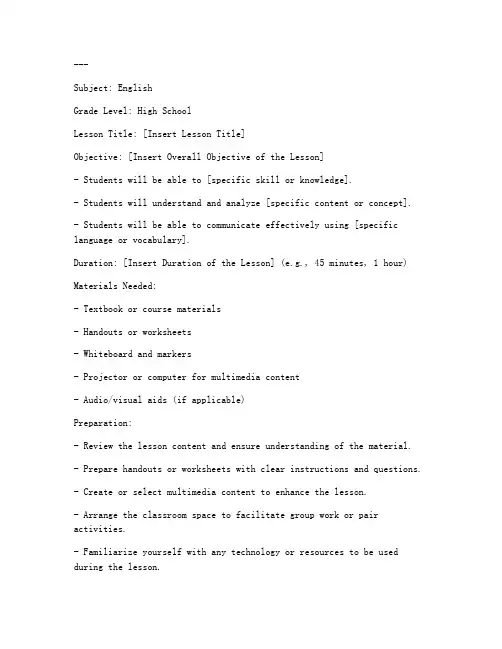
Subject: EnglishGrade Level: High SchoolLesson Title: [Insert Lesson Title]Objective: [Insert Overall Objective of the Lesson]- Students will be able to [specific skill or knowledge].- Students will understand and analyze [specific content or concept].- Students will be able to communicate effectively using [specific language or vocabulary].Duration: [Insert Duration of the Lesson] (e.g., 45 minutes, 1 hour) Materials Needed:- Textbook or course materials- Handouts or worksheets- Whiteboard and markers- Projector or computer for multimedia content- Audio/visual aids (if applicable)Preparation:- Review the lesson content and ensure understanding of the material. - Prepare handouts or worksheets with clear instructions and questions. - Create or select multimedia content to enhance the lesson.- Arrange the classroom space to facilitate group work or pair activities.- Familiarize yourself with any technology or resources to be used during the lesson.Warm-Up (5 minutes)Activity: [Insert Warm-Up Activity]- Purpose: To engage students and activate prior knowledge.- Procedures:1. Begin with a brief discussion or question related to the lesson topic.2. Have students share their thoughts or experiences.3. Transition smoothly into the main part of the lesson.---Introduction (10 minutes)Activity: [Insert Introduction Activity]- Purpose: To introduce the lesson topic and objectives.- Procedures:1. Briefly introduce the topic using a hook (e.g., a question, a video clip, a picture).2. Clearly state the lesson objectives and expectations.3. Provide a brief overview of the lesson structure.---Main Content (25 minutes)Activity 1: [Insert Activity 1]- Purpose: To introduce new vocabulary or concepts.- Procedures:1. Present the new vocabulary or concepts through visual aids, examples, or explanations.2. Have students practice using the new language through interactive activities or exercises.3. Provide feedback and clarification as needed.Activity 2: [Insert Activity 2]- Purpose: To reinforce understanding and application of the new content.- Procedures:1. Conduct a group activity or pair work to apply the new knowledge.2. Provide guidance and support as students work together.3. Encourage students to share their findings or responses.Activity 3: [Insert Activity 3]- Purpose: To deepen understanding and critical thinking.- Procedures:1. Engage students in a discussion or debate related to the lesson topic.2. Use questioning techniques to encourage higher-order thinking.3. Summarize key points and provide additional information if necessary.---Conclusion (5 minutes)Activity: [Insert Conclusion Activity]- Purpose: To review the lesson and reinforce learning.- Procedures:1. Summarize the main points covered in the lesson.2. Ask students to share their learning or reflections.3. Assign homework or provide additional resources for further learning.---Homework Assignment:- [Insert Homework Assignment]- Purpose: To reinforce learning and provide additional practice.---Assessment:- [Insert Assessment Methods]- Purpose: To evaluate student understanding and achievement of the lesson objectives.---Reflection:- [Insert Reflection Questions]- Purpose: To encourage self-assessment and reflection on the lesson.---This template provides a structured outline for creating a high school English lesson plan. Adjust the activities, duration, and materials as needed to fit the specific requirements of your curriculum and student needs.。
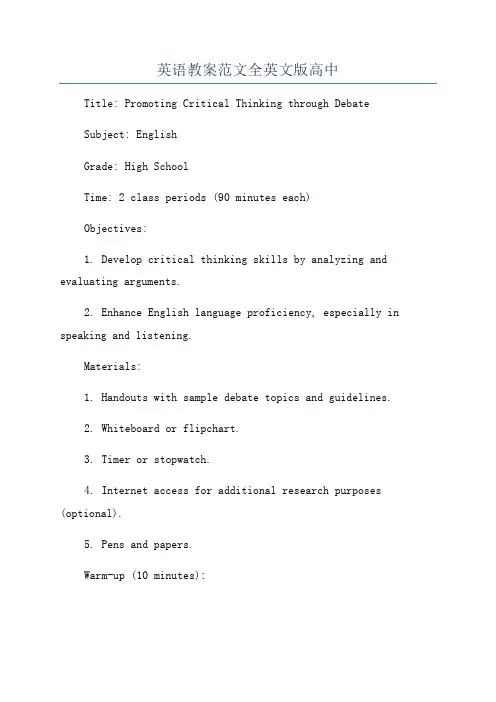
英语教案范文全英文版高中Title: Promoting Critical Thinking through DebateSubject: EnglishGrade: High SchoolTime: 2 class periods (90 minutes each)Objectives:1. Develop critical thinking skills by analyzing and evaluating arguments.2. Enhance English language proficiency, especially in speaking and listening.Materials:1. Handouts with sample debate topics and guidelines.2. Whiteboard or flipchart.3. Timer or stopwatch.4. Internet access for additional research purposes (optional).5. Pens and papers.Warm-up (10 minutes):1. Begin the class by asking students about their understanding of a debate. Encourage them to share their personal experiences or observations.2. Write their responses on the whiteboard to create a mind map of ideas.Introduction to Debating (15 minutes):1. Introduce the concept of debating, explaining its purpose and structure.3. Present a few sample debate topics and ask students to brainstorm arguments for both sides.Main Activities:Activity 1: Analyzing Arguments (30 minutes):1. Divide the class into small groups of 4-5 students.2. Distribute handouts with sample debate topics and guidelines.3. Instruct each group to choose a topic and assign team members to take positions either for or against the proposition.5. Have each group present their arguments to the class and encourage open discussion.Activity 2: Structured Debate (60 minutes):1. Divide the class into two larger teams: Affirmative and Negative.2. Assign each team a debate topic and provide them with the necessary materials.3. Give the teams 10 minutes to prepare their arguments and rebuttals.4. Set up the debate format as follows:a. Team Affirmative presents their opening statement (5 minutes).b. Team Negative presents their opening statement (5 minutes).c. Team Affirmative presents their arguments (5 minutes).d. Team Negative presents their arguments (5 minutes).e. Team Affirmative presents their rebuttals (3 minutes).f. Team Negative presents their rebuttals (3 minutes).g. Questions and answers session between the teams (10 minutes).h. Closing statements from both teams (3 minutes each).6. Encourage active participation from the audience by taking notes and asking questions during the Q&A session.Closure (10 minutes):1. Facilitate a class discussion about the effectiveness of the debates.2. Ask students to reflect on the critical thinking skills they used and how it impacted their arguments.3. Discuss different techniques used in persuasive speaking and how they could be improved.Homework:1. Assign students to write a reflective essay on their experiences during the debate.2. Provide a list of follow-up questions for students to consider in their essays, such as:a. How did the debate challenge your critical thinking skills?b. Did your initial opinion on the topic change after hearing the arguments?c. How did you handle opposing viewpoints during the Q&A session?d. What are some areas you can improve on for future debates?Notes:- Adjust the debate topics and difficulty level according to the English proficiency and interest of the students.- Encourage students to conduct additional research for more in-depth arguments.。
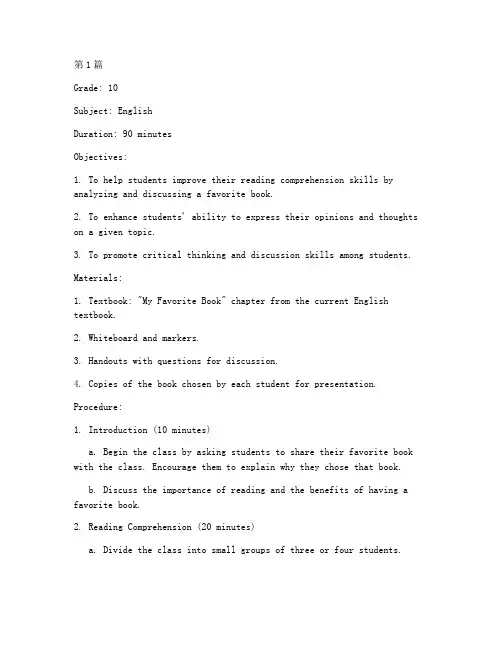
第1篇Grade: 10Subject: EnglishDuration: 90 minutesObjectives:1. To help students improve their reading comprehension skills by analyzing and discussing a favorite book.2. To enhance students' ability to express their opinions and thoughts on a given topic.3. To promote critical thinking and discussion skills among students.Materials:1. Textbook: "My Favorite Book" chapter from the current English textbook.2. Whiteboard and markers.3. Handouts with questions for discussion.4. Copies of the book chosen by each student for presentation.Procedure:1. Introduction (10 minutes)a. Begin the class by asking students to share their favorite book with the class. Encourage them to explain why they chose that book.b. Discuss the importance of reading and the benefits of having a favorite book.2. Reading Comprehension (20 minutes)a. Divide the class into small groups of three or four students.b. Assign each group a specific section from the "My Favorite Book" chapter to read.c. After reading, ask each group to discuss the following questions:- What is the main idea of the section?- How does the author convey the message?- What are the key themes and characters?d. Assign a representative from each group to share their findings with the class.3. Presentation and Discussion (30 minutes)a. Ask each student to bring a copy of their favorite book to class.b. Choose one student from each group to present their favorite book to the class.c. The presenter should include the following in their presentation:- Title of the book- Author- Brief summary of the story- Why it is their favorite book- Key themes and characters- Personal connections or lessons learnedd. After each presentation, open the floor for class discussion. Encourage students to ask questions and share their thoughts on the presented books.4. Writing Activity (20 minutes)a. Provide students with a writing prompt related to their favorite book:- If you could meet one character from your favorite book, who would it be and why?- How has reading your favorite book influenced your life?b. Give students 20 minutes to write a short essay on the prompt.c. Circulate around the classroom to provide feedback and assistance as needed.5. Conclusion (10 minutes)a. Conclude the class by summarizing the key points discussed during the lesson.b. Encourage students to continue reading and sharing their favorite books with others.c. Assign a homework assignment to read a new book and be prepared to discuss it in the next class.Assessment:1. Participation in class discussions and group activities.2. Completion of the writing assignment.3. Engagement in the presentation and discussion of favorite books.第2篇Grade Level: 11Subject: English Language ArtsDuration: 90 minutesTeaching Objectives:1. To understand the positive and negative impacts of technology on society.2. To analyze different perspectives on the role of technology in modern life.3. To improve writing skills by composing a persuasive essay on the topic.4. To enhance critical thinking and public speaking skills through group discussions and presentations.Materials:- Projector and computer for showing videos and presentations.- Handouts with articles and discussion questions.- Writing materials (pencils, paper, etc.).- Whiteboard and markers.Preparation:1. Prepare a PowerPoint presentation or video clips that illustrate the impact of technology on various aspects of society.2. Collect and print articles or extracts from books that present different viewpoints on the topic.3. Create a handout with guiding questions for discussion.Procedure:Warm-Up (10 minutes):1. Begin the class with a brief discussion about the students' experiences with technology. Ask them to share examples of how technology has affected their daily lives.2. Write down their responses on the whiteboard to create a class list of technology's impacts.Introduction (10 minutes):1. Introduce the topic of the lesson by showing a short video or a series of images that depict the rapid advancement of technology and its effects on society.2. Present the objectives of the lesson and explain the structure of the class.Group Discussion (20 minutes):1. Divide the class into small groups of four or five students.2. Provide each group with a handout containing articles or extractsthat present different viewpoints on the impact of technology.3. Instruct students to read the materials and discuss the following questions:- What are the positive impacts of technology on society?- What are the negative impacts of technology on society?- How do different people view the role of technology in modern life?- What solutions can be proposed to mitigate the negative impacts of technology?Group Presentations (20 minutes):1. Assign each group a specific viewpoint on the topic (e.g., technology is beneficial, technology is harmful, technology is a double-edged sword).2. Instruct each group to prepare a 5-minute presentation on their chosen viewpoint, using the information from their discussions and the articles provided.3. Allow each group to present their findings to the class.Writing Activity (20 minutes):1. After the presentations, give students a writing prompt that requires them to compose a persuasive essay on the impact of technology on society.2. Provide a list of key points that they should include in their essay, such as:- Introduction with a clear thesis statement- Body paragraphs supporting the thesis with examples and evidence- Conclusion summarizing the main points and restating the thesisWrap-Up (10 minutes):1. Conclude the lesson by asking students to reflect on what they have learned about the impact of technology on society.2. Discuss the importance of critical thinking when evaluating the benefits and drawbacks of technological advancements.3. Assign the writing task as homework and encourage students to continue their research on the topic.Homework:- Write a 500-word persuasive essay on the impact of technology on society, incorporating at least three examples and a clear thesis statement.Assessment:- Evaluate the group discussions and presentations based on participation, clarity of argument, and coherence of ideas.- Assess the written essays on the quality of argumentation, evidence provided, and adherence to the essay structure.第3篇Subject: English Language ArtsGrade Level: 11th GradeDuration: 90 minutesObjective:Students will be able to understand and analyze the concept of the American Dream, identify its historical context, and express their own perspectives on the American Dream through writing and discussion.Materials:- Projector and computer for showing multimedia presentations- Handouts with historical context information- Writing materials (pencils, paper, etc.)- Class set of copies of "The Great Gatsby" by F. Scott Fitzgerald (if applicable)- Interactive whiteboard or blackboard- American Dream timeline and mapPreparation:1. Prepare a multimedia presentation that includes images, videos, and quotes related to the American Dream.2. Create handouts with historical context information about the American Dream.3. Write guiding questions for the discussion.4. Prepare a writing prompt related to the American Dream.5. Set up the interactive whiteboard or blackboard with a timeline and map of the United States.Warm-Up (10 minutes):- Begin the class with a brief discussion about the definition of the American Dream. Ask students to share their personal understanding of the concept.Introduction (10 minutes):- Show the multimedia presentation to introduce the concept of the American Dream. Highlight key historical events and figures that have contributed to the development of this idea.- Discuss the origins of the American Dream, tracing it back to the Declaration of Independence and the ideas of freedom, equality, and opportunity.Main Activity (30 minutes):1. Historical Context:- Distribute handouts with historical context information.- Have students work in pairs to read and discuss the handouts, identifying key points about the American Dream throughout history.- Bring the class back together for a brief presentation by each pair, allowing them to share their findings.2. Group Discussion:- Post guiding questions on the interactive whiteboard or blackboard.- Divide the class into small groups and assign each group a question to discuss. For example:- How has the American Dream changed over time?- What are the challenges and opportunities that immigrants face in achieving the American Dream?- How does the American Dream relate to the social and economic issues of today?- Allow each group 10 minutes to discuss their assigned question,then facilitate a whole-class discussion, encouraging students to share their thoughts and perspectives.3. Reading Activity:- If applicable, assign a short passage from "The Great Gatsby" related to the American Dream.- Have students read the passage and discuss how the novel portrays the American Dream.Writing Activity (20 minutes):- Distribute writing prompts related to the American Dream.- Instruct students to write a short essay (250-300 words) answering the prompt. For example:- Write an essay explaining whether or not you believe the American Dream is still achievable today. Support your answer with examples from your own life or from the material we have discussed in class.- Imagine you are a character from a historical period that we have studied. Write a letter to your descendants about the American Dream and your experiences with it.Conclusion (10 minutes):- Review the key points discussed during the lesson.- Encourage students to reflect on their own understanding of the American Dream and how it has been shaped by their personal experiences and the information presented in class.- Assign the writing essays as homework and inform students of the due date.Assessment:- Participation in discussions and group activities- Quality of the written essay- Ability to express personal perspectives on the American DreamFollow-Up Activities:- Organize a class debate on whether the American Dream is still achievable today.- Assign a research project on a historical figure who has contributed to the American Dream.- Create a class presentation or video about the American Dream, using images, music, and personal testimonials.。
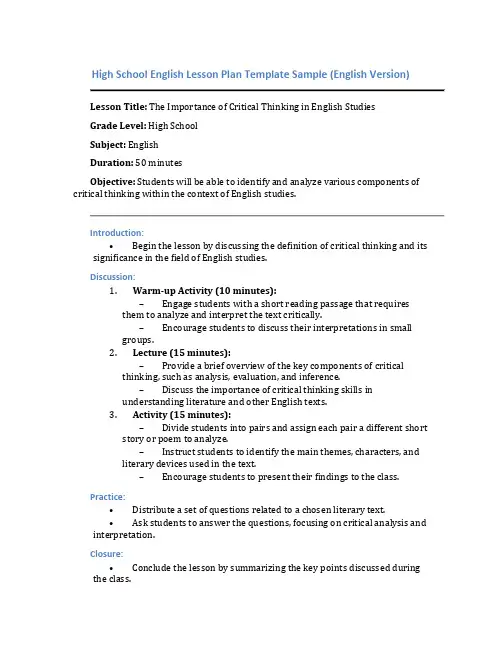
High School English Lesson Plan Template Sample (English Version)Lesson Title: The Importance of Critical Thinking in English StudiesGrade Level: High SchoolSubject: EnglishDuration: 50 minutesObjective: Students will be able to identify and analyze various components of critical thinking within the context of English studies.Introduction:•Begin the lesson by discussing the definition of critical thinking and its significance in the field of English studies.Discussion:1.Warm-up Activity (10 minutes):–Engage students with a short reading passage that requires them to analyze and interpret the text critically.–Encourage students to discuss their interpretations in small groups.2.Lecture (15 minutes):–Provide a brief overview of the key components of critical thinking, such as analysis, evaluation, and inference.–Discuss the importance of critical thinking skills inunderstanding literature and other English texts.3.Activity (15 minutes):–Divide students into pairs and assign each pair a different short story or poem to analyze.–Instruct students to identify the main themes, characters, and literary devices used in the text.–Encourage students to present their findings to the class.Practice:•Distribute a set of questions related to a chosen literary text.•Ask students to answer the questions, focusing on critical analysis and interpretation.Closure:•Conclude the lesson by summarizing the key points discussed during the class.•Encourage students to continue practicing their critical thinking skills in future English studies.Assessment:•Assess students based on their participation in the group discussions, ability to analyze literary texts critically, and responses to the practicequestions.Homework:•Assign students a reading assignment that requires them to apply critical thinking skills to analyze a selected piece of literature.This lesson plan template aims to guide high school English teachers in designing engaging and effective lessons that promote critical thinking skills among students. By incorporating various activities and discussions, students can enhance their ability to analyze and interpret English texts more effectively.。
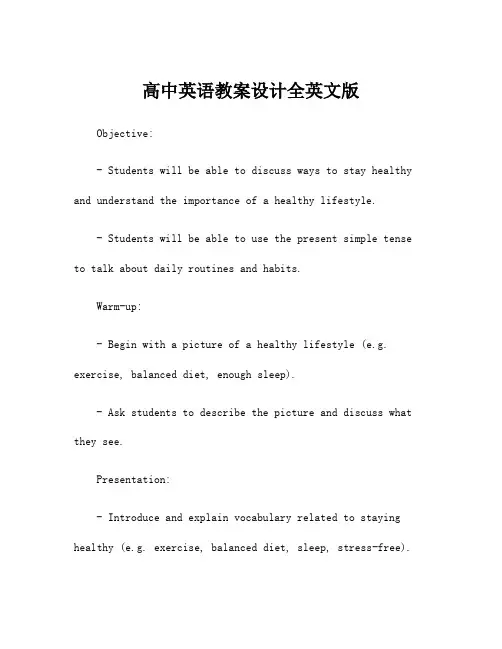
高中英语教案设计全英文版Objective:- Students will be able to discuss ways to stay healthy and understand the importance of a healthy lifestyle.- Students will be able to use the present simple tense to talk about daily routines and habits.Warm-up:- Begin with a picture of a healthy lifestyle (e.g. exercise, balanced diet, enough sleep).- Ask students to describe the picture and discuss what they see.Presentation:- Introduce and explain vocabulary related to staying healthy (e.g. exercise, balanced diet, sleep, stress-free).- Show pictures or short video clips to illustrate each concept.Practice:- Group students into pairs or small groups and have them discuss their daily routines and habits related to staying healthy.- Elicit responses from each group and provide feedback on the use of vocabulary and grammar.Production:- In pairs, students will create a short dialogue about a healthy lifestyle, incorporating the vocabulary and grammar discussed in class.- Randomly select a few pairs to perform their dialogues in front of the class.Conclusion:- Review the key concepts and vocabulary related to staying healthy.- Assign homework to have students write a short paragraph about their own healthy habits and routines.。
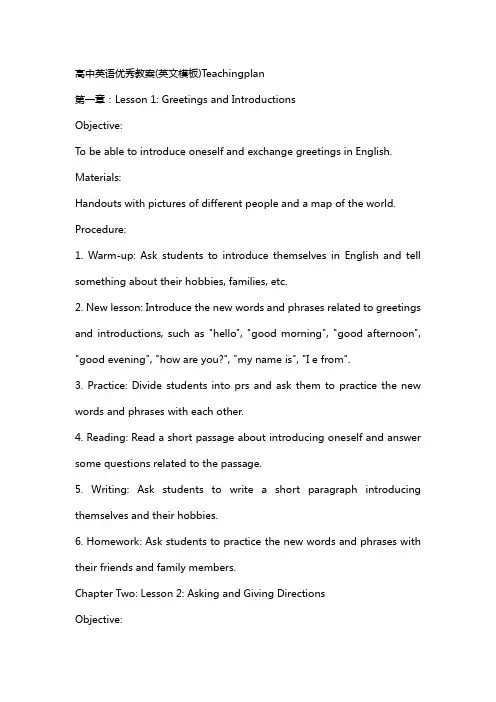
高中英语优秀教案(英文模板)Teachingplan第一章:Lesson 1: Greetings and IntroductionsObjective:To be able to introduce oneself and exchange greetings in English. Materials:Handouts with pictures of different people and a map of the world. Procedure:1. Warm-up: Ask students to introduce themselves in English and tell something about their hobbies, families, etc.2. New lesson: Introduce the new words and phrases related to greetings and introductions, such as "hello", "good morning", "good afternoon", "good evening", "how are you?", "my name is", "I e from".3. Practice: Divide students into prs and ask them to practice the new words and phrases with each other.4. Reading: Read a short passage about introducing oneself and answer some questions related to the passage.5. Writing: Ask students to write a short paragraph introducing themselves and their hobbies.6. Homework: Ask students to practice the new words and phrases with their friends and family members.Chapter Two: Lesson 2: Asking and Giving DirectionsObjective:To be able to ask for and give directions in English.Materials:Handouts with pictures of different places in the school and a map of the city.Procedure:1. Warm-up: Ask students to ask and answer questions in English, such as "Where is the library?", "How can I get to the park?".2. New lesson: Introduce the new words and phrases related to asking and giving directions, such as "where is", "how can I get to", "turn left", "turn right", "go strght".3. Practice: Divide students into prs and ask them to practice the new words and phrases with each other.4. Reading: Read a short passage about asking for directions and answer some questions related to the passage.5. Writing: Ask students to write a short paragraph giving directions from one place to another.6. Homework: Ask students to practice the new words and phrases with their friends and family members.Chapter Three: Lesson 3: Ordering Food in a RestaurantObjective:To be able to order food in English at a restaurant.Materials:Handouts with pictures of different food and a menu.Procedure:1. Warm-up: Ask students to practice asking for and giving opinions in English, such as "Do you like pizza?", "Yes, I do. I like pepperoni."2. New lesson: Introduce the new words and phrases related to ordering food, such as "I'd like", "I'd like to order", "can I have", "what do you remend?", "I'll have".3. Practice: Divide students into prs and ask them to practice the new words and phrases with each other while acting out ordering food at a restaurant.4. Reading: Read a short passage about ordering food in a restaurant and answer some questions related to the passage.5. Writing: Ask students to write a short dialogue between two people ordering food at a restaurant.6. Homework: Ask students to practice the new words and phrases with their friends and family members.Chapter Four: Lesson 4: Discussing Hobbies and Interests Objective:To be able to discuss hobbies and interests in English.Materials:Handouts with pictures of different hobbies and interests. Procedure:1. Warm-up: Ask students to practice asking and answering questions about hobbies and interests in English, such as "What do you like to do in your free time?", "I like to read books."2. New lesson: Introduce the new words and phrases related to hobbies and interests, such as "I like to", "I enjoy", "my favorite", "I'd rather", "I can't stand".3. Practice: Divide students into prs and ask them to practice the new words and phrases with each other while discussing their own hobbies and interests.4. Reading: Read a short passage about discussing hobbies and interests and answer some questions related to the passage.5. Writing: Ask students to write a short paragraph discussing their own hobbies and interests.6. Homework: Ask students to practice the new words and phrases with their friends and family members.Chapter Five: Lesson 5: Describing People and PlacesObjective:To be able to describe people and places in English.Materials:第六章:Lesson 6: Describing People and Places (Continued) Objective:To be able to describe people and places in English.Handouts with pictures of different people and places.Procedure:1. Warm-up: Ask students to practice asking and answering questions about people and places in English, such as "What does she look like?", "He is tall and thin."2. New lesson: Introduce the new words and phrases related to describing people and places, such as "She has long hr.", "The city is beautiful."3. Practice: Divide students into prs and ask them to practice the new words and phrases with each other while describing people and places.4. Reading: Read a short passage about describing people and places and answer some questions related to the passage.5. Writing: Ask students to write a short paragraph describing a person or a place they know.6. Homework: Ask students to practice the new words and phrases with their friends and family members.第七章:Lesson 7: Asking and Giving PermissionObjective:To be able to ask for and give permission in English.Materials:Handouts with pictures of different situations asking for permission.1. Warm-up: Ask students to practice asking for and giving permission in English, such as "Can I use your pen?", "Yes, you can."2. New lesson: Introduce the new words and phrases related to asking and giving permission, such as "Can I", "May I", "Do you mind", "Sure", "No problem".3. Practice: Divide students into prs and ask them to practice the new words and phrases with each other while acting out situations asking for permission.4. Reading: Read a short passage about asking for and giving permission and answer some questions related to the passage.5. Writing: Ask students to write a short dialogue between two people asking for and giving permission.6. Homework: Ask students to practice the new words and phrases with their friends and family members.第八章:Lesson 8: Talking About Past EventsObjective:To be able to talk about past events in English.Materials:Handouts with pictures of different past events.Procedure:1. Warm-up: Ask students to practice asking and answering questionsabout past events in English, such as "What did you do yesterday?", "I went to the park."2. New lesson: Introduce the new words and phrases related to talking about past events, such as "yesterday", "today", "tomorrow", "yesterday", "last week", "last month", "last year".3. Practice: Divide students into prs and ask them to practice the new words and phrases with each other while talking about past events.4. Reading: Read a short passage about talking about past events and answer some questions related to the passage.5. Writing: Ask students to write a short paragraph describing what they did yesterday.6. Homework: Ask students to practice the new words and phrases with their friends and family members.第九章:Lesson 9: Making and Canceling PlansObjective:To be able to make and cancel plans in English.Materials:Handouts with pictures of different plans and situations. Procedure:1. Warm-up: Ask students to practice making and canceling plans in English, such as "Can we meet on Sunday?", "Sure, see you then."2. New lesson: Introduce the new words and phrases related to makingand canceling plans, such as "I'd like to", "I can", "I can't", "I'm sorry", "let's", "we can".3. Practice: Divide students into prs and ask them to practice the new words and phrases with each other while making and canceling plans.4. Reading: Read a short passage about making and canceling plans and answer some questions related to the passage.5. Writing: Ask students to write a short dialogue between two people making and canceling plans.6. Homework: Ask students to practice the new words and phrases with their friends and family members.第十章:Lesson 10: Expressing Opinions and Agreeing/Disagreeing Objective:To be able to express opinions and agree/disagree in English. Materials:Handouts with pictures of different topics and situations. Procedure:1. Warm-up: Ask students to practice expressing重点解析重点:1. 目标(Objective):明确本节课的学习目标,使学生能够掌握特定的英语知识和技能。
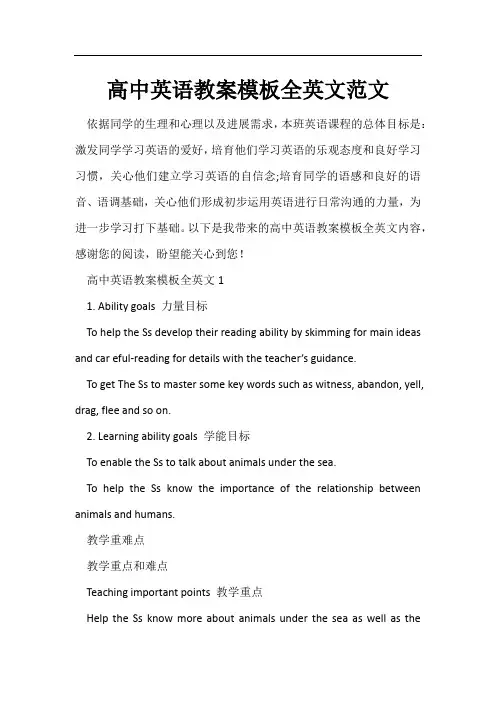
高中英语教案模板全英文范文依据同学的生理和心理以及进展需求,本班英语课程的总体目标是:激发同学学习英语的爱好,培育他们学习英语的乐观态度和良好学习习惯,关心他们建立学习英语的自信念;培育同学的语感和良好的语音、语调基础,关心他们形成初步运用英语进行日常沟通的力量,为进一步学习打下基础。
以下是我带来的高中英语教案模板全英文内容,感谢您的阅读,盼望能关心到您!高中英语教案模板全英文11. Ability goals 力量目标To help the Ss develop their reading ability by skimming for main ideas and car eful-reading for details with the teacher’s guidance.To get The Ss to master some key words such as witness, abandon, yell, drag, flee and so on.2. Learning ability goals 学能目标To enable the Ss to talk about animals under the sea.To help the Ss know the importance of the relationship between animals and humans.教学重难点教学重点和难点Teaching important points 教学重点Help the Ss know more about animals under the sea as well as theanimals’ loyalty and help to human bein gs.Teaching difficult points 教学难点1. Help the Ss get the main idea and some detailed information by fast-reading and careful-reading.2. Help the Ss tell apart from Before, During and After in the story.教学过程Step1. Warming Up : Talk about animals under the sea.1. Have you ever seen some marine animals?2. What have you seen, and where have you seen them?I have seen a/some/many…… in/on/from……amazing marine animals: seal, turtle, dolphin, sea-horse, sea-star, shark, angelfish, jellyfish, lobster, coralStep2. Fast-reading:1. Find out the Background Information of the story : writer, career, writing style, time, place, main character.2. Find out the Main Idea of the passage: What’s the first story mainly about?Step3. Careful-reading:1. Clancy had heard of the killer whales that every year killer whales would help whalers catch baleen whales. Did he believe it at first? When did he believe it was a true anecdote?2. How many paragraphs are there all together in story1? The hunt canbe divided into 3 stages.Stage1: before the hunt: (para. 2-6):Old Tom’s doing: throwing itself out of … and crashing down again… Why? to tell the whalers…, …by the boat…, circling back to …Why? to lead the whalers…Whalers’ reaction: Another whaler __________. George _____ ___ _____ Clancy, and Clancy ______ after him. They __________ the boat and ______ ____into the bay.Stage23: Dur ing and after the hunt: (para. 7-9):Killer whale’s doing: The killers over there are ________ themselves on the top of the whale’s blow-hole to stop it __________; and some others are stopping it _______ out to sea. The killers started ________ between our boat and the whale just like a pack of ____ ___ dogs. When the baleen whale was dead, its body wa s _______ down into the depths of the sea.Whalers’ reaction: The man in the bow of the boat aimed the harpoon at the whale and then let it go to hit the spot.Conclusion: They have amazing relationship. They work as a team Step4 : SummaryWorking at the _______station, I had the chance to _________ a baleen whale being attacked by a ______ of k iller whales.On the afternoon I arrived at the station, as I was __________ myaccommodation, I heard a loud noise coming from the bay. I ran down to the ______ in time to see an enormous animal _________ itself out of the water and then _______________ again. George told me it was Old Tom, who announced there would be a ___________.Using a _________, we could see a baleen whale _______________ by about six killers. Some are ________ themselves on top of the whale’s __________to stop it breathing; and some others are stopping it _______ out to sea. The whalers aimed the ________ at the whale and then let it go to hit the spot. Being badly ________, the whale soon died. Very soon, its body was ________ by the killers down into the _______ of the sea.课后习题课后作业Deal with Exercise 3 in Comprehending . Let the Ss work in groups and do some discussion:As a matter of fact, whales are now an endangered animal. Many people are trying to protect them from being hunted. The last whaling station in Australia closed in 1978. But some countries oppose the ban. An d there are still people who hunt whales. What’s your opinion? Are you for or against the banning whaling? Consider the problem carefully and we’ll have a discussion tomorrow.高中英语教案模板全英文2(1)课题:Friendship(2)教材分析与同学分析:本单元的中心话题是“友情”,几乎全部的内容都是围绕这一中心话题绽开的。
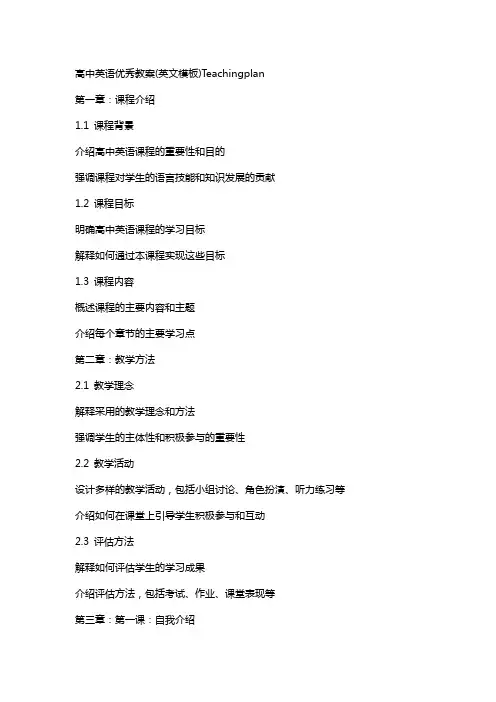
高中英语优秀教案(英文模板)Teachingplan第一章:课程介绍1.1 课程背景介绍高中英语课程的重要性和目的强调课程对学生的语言技能和知识发展的贡献1.2 课程目标明确高中英语课程的学习目标解释如何通过本课程实现这些目标1.3 课程内容概述课程的主要内容和主题介绍每个章节的主要学习点第二章:教学方法2.1 教学理念解释采用的教学理念和方法强调学生的主体性和积极参与的重要性2.2 教学活动设计多样的教学活动,包括小组讨论、角色扮演、听力练习等介绍如何在课堂上引导学生积极参与和互动2.3 评估方法解释如何评估学生的学习成果介绍评估方法,包括考试、作业、课堂表现等第三章:第一课:自我介绍3.1 教学目标明确第一课的学习目标,包括词汇和语法点强调学生的参与和互动3.2 教学内容介绍第一课的主题和主要学习点提供详细的词汇和语法解释3.3 教学步骤设计教学步骤,包括导入、新课讲解、练习和总结提供具体的教学指令和指导3.4 作业和练习设计作业和练习,巩固所学内容提供答案和解析第四章:第二课:日常对话4.1 教学目标明确第二课的学习目标,包括听力理解和口语表达强调学生的积极参与和互动4.2 教学内容介绍第二课的主题和主要学习点提供详细的听力材料和口语表达指导4.3 教学步骤设计教学步骤,包括听力练习、口语表达和对话练习提供具体的教学指令和指导4.4 作业和练习设计作业和练习,巩固所学内容提供答案和解析第五章:第三课:家庭和朋友5.1 教学目标明确第三课的学习目标,包括阅读理解和写作表达强调学生的积极参与和互动5.2 教学内容介绍第三课的主题和主要学习点提供详细的阅读材料和写作指导5.3 教学步骤设计教学步骤,包括阅读理解、写作表达和小组讨论提供具体的教学指令和指导5.4 作业和练习设计作业和练习,巩固所学内容提供答案和解析第六章:第四课:节日和文化6.1 教学目标明确第四课的学习目标,包括文化意识和语言运用强调学生的参与和互动6.2 教学内容介绍第四课的主题和主要学习点提供详细的文化背景知识和语言运用指导6.3 教学步骤设计教学步骤,包括文化介绍、语言运用和小组讨论提供具体的教学指令和指导6.4 作业和练习设计作业和练习,巩固所学内容提供答案和解析第七章:第五课:旅游和交通7.1 教学目标明确第五课的学习目标,包括词汇学习和语言运用强调学生的积极参与和互动7.2 教学内容介绍第五课的主题和主要学习点提供详细的词汇解释和语言运用指导7.3 教学步骤设计教学步骤,包括词汇学习、语言运用和角色扮演提供具体的教学指令和指导7.4 作业和练习设计作业和练习,巩固所学内容提供答案和解析第八章:第六课:健康和生活方式8.1 教学目标明确第六课的学习目标,包括健康知识和语言运用强调学生的参与和互动8.2 教学内容介绍第六课的主题和主要学习点提供详细的健康知识和语言运用指导8.3 教学步骤设计教学步骤,包括健康知识介绍、语言运用和小组讨论提供具体的教学指令和指导8.4 作业和练习设计作业和练习,巩固所学内容提供答案和解析第九章:第七课:环境保护9.1 教学目标明确第七课的学习目标,包括环保意识和语言运用强调学生的参与和互动9.2 教学内容介绍第七课的主题和主要学习点提供详细的环保知识和语言运用指导9.3 教学步骤设计教学步骤,包括环保知识介绍、语言运用和小组讨论提供具体的教学指令和指导9.4 作业和练习设计作业和练习,巩固所学内容提供答案和解析第十章:第八课:未来规划10.1 教学目标明确第八课的学习目标,包括规划能力和语言运用强调学生的参与和互动10.2 教学内容介绍第八课的主题和主要学习点提供详细的规划能力和语言运用指导10.3 教学步骤设计教学步骤,包括规划能力培养、语言运用和个人陈述提供具体的教学指令和指导10.4 作业和练习设计作业和练习,巩固所学内容提供答案和解析第十一章:第九课:媒体与新闻11.1 教学目标明确第九课的学习目标,包括媒体素养和语言运用强调学生的参与和互动11.2 教学内容介绍第九课的主题和主要学习点提供详细的媒体素养知识和语言运用指导11.3 教学步骤设计教学步骤,包括媒体知识介绍、语言运用和小组讨论提供具体的教学指令和指导11.4 作业和练习设计作业和练习,巩固所学内容提供答案和解析第十二章:第十课:科学和技术12.1 教学目标明确第十课的学习目标,包括科学知识和技术运用强调学生的积极参与和互动12.2 教学内容介绍第十课的主题和主要学习点提供详细的科学和技术知识指导12.3 教学步骤设计教学步骤,包括科学知识介绍、技术运用和实践操作提供具体的教学指令和指导12.4 作业和练习设计作业和练习,巩固所学内容提供答案和解析第十三章:第十一课:历史与文化13.1 教学目标明确第十一课的学习目标,包括历史知识和文化理解强调学生的参与和互动13.2 教学内容介绍第十一课的主题和主要学习点提供详细的历史和文化知识指导13.3 教学步骤设计教学步骤,包括历史知识介绍、文化理解和小组讨论提供具体的教学指令和指导13.4 作业和练习设计作业和练习,巩固所学内容提供答案和解析第十四章:第十二课:艺术与审美14.1 教学目标明确第十二课的学习目标,包括艺术欣赏和审美能力强调学生的参与和互动14.2 教学内容介绍第十二课的主题和主要学习点提供详细的art 知识和审美指导14.3 教学步骤设计教学步骤,包括艺术欣赏、审美讨论和创作实践提供具体的教学指令和指导14.4 作业和练习设计作业和练习,巩固所学内容提供答案和解析第十五章:总复习与考试准备15.1 教学目标明确总复习与考试准备的学习目标,包括巩固知识和提高应试能力强调学生的积极参与和互动15.2 教学内容总结整个学期的学习内容,重点复习重要知识点和技能提供考试准备策略和技巧15.3 教学步骤设计教学步骤,包括知识点复习、模拟试题练习和考试策略讲解提供具体的教学指令和指导15.4 作业和练习设计作业和练习,巩固所学内容提供答案和解析重点和难点解析重点:课程介绍、教学方法、各个主题的学习内容、教学活动、评估方法。
英语全英文教案高中【篇一:高中英文教案】高中5班47号赵冬菊background informationstudents: 60 senior 2 studentslesson duration: 15 minsteaching content: nsec book 6 unit3 computersteaching aims: 1. enable students to understand the whole passage. 2 .improve students’ ability of gathering information.3. let students know some basic information about computers. teaching important points:1.students will be able to grasp some words and phrases if they don’t know.2.to be able to know about the history about computers.teaching difficult points: students will be able to the history of computers in english.teaching method: task-based language teaching, communicative approach, audio-lingual method and heuristic method.teaching aids :multimedia,physical objects.teaching procedures:step1 : organizationt: ok, class begins good morning, everyone.s: good morning, teacher.t:ok,sit down, please.step2:lead-int:i prepared some riddles .do you want to guess?s:yest:i am very old now. i was born in china. many people used me for calculating in the past,but now i am a bit lonely because they don’t like me now.do you know who i am?s:abacus.t:very good.i am very small.i can be used for calculating.in china,a lot of students use me when solving mathematical problems.do you know who i am?s:calculator.t:great,then can you tell me the development ofcomputers?s:abacua-calculator-huge computer-pc-laptop-pda-robott:what is next?s:work for us in mars.step3:presentation1. fast readingt:and first i want you to read this quickly and try to find the main idea of this text.but do you remember,before you reading,pay attention to the title and the headlines and also the pictures in the text.and then,read the first paragraph or the first sentence of each paragraph.then you can summarize the main idea.are you clear? s:yest:ok,time is up.can you find the answer?what’s the main idea of the text?s:no answer from the studentst:ok,i’ll give you some choices.you can choose the rightone.which one is correct?s:bt:yes,b is correct.the main idea of this passage is the development and use of computers.t:who is the speaker in this story?s:a computer.t:well done.2. careful readingt:ok,let’s look through these characteristics of each period,we should know more information about them.let’s read the test again.this time,i will give you 5minutes to finish this part.you should read it carefully.and finish the timeline below.s:silent readingt:time is up.ok,can you fill in the blanks?in 1642?s:the computer began as a calculating machine.t:well done.after 1822,how can you fill it?s:in 1936,the computer grew rapidly both in size and in brainpower. t:good job.after 1940s,who can fill the blank?s:the computer had grown as large as a room.t:that’s right,which year can write between 1940s and 1970s? s:1960st:great.how do computers develop in 1970s?s:computers were used in offices and homes.t:and now?s:now,computers connect people all over the world tigether.t:wonderful.step4:consolidate and practicet:we can summarize adventages and disadvantages of the computers. s:we can communicate with friends,listen to the music and play games.t:and disadvantages?s:some people especially the teenagers abandon themselvesto the computer games and chatting on the internet,as aresult,they have little time to study.t:yeah,very good.step5:homework design1. review the passage2. write a composition about advantages and disadvanteges of internet.【篇二:高中英语教案范例】新年第一节英语课(高一教案)step i greetings and lead in(问候以及导入)1. happy new year!t: well, i am so happy to see you again after the long vacation.i wish everyone of you had a happy holiday. so how about your holiday? had you done some travel? 2. learn someexpressions about “dragon”(学习一些关于中国龙的习语、成语)t: this year is the year of dragon, so we will play a guessing game. i will show the english expressions and you try to guess the chinese expressions, long included.step ii revision(复习)1. dear, how many words can you still remember after amonths winter holiday?2. 2. how many phrases can you still remember?3.3. do you still remember the grammar very closely?there is no shortcut in the science road ,only be deligent.在科学上没有平坦的大道,只有不畏劳苦沿着陡峭山路攀登的人,才有希望达到光辉的顶点。
Subject: EnglishGrade Level: High SchoolLesson Title: [Title of the Lesson]Objective(s):- To [main objective of the lesson].- To [secondary objective of the lesson].- To [additional objective of the lesson].Materials Needed:- Textbook and workbook- Whiteboard and markers- Projector or Smartboard- Handouts or worksheets- Video clip or audio recording (if applicable)- Computers or tablets (for interactive activities)Warm-Up (5 minutes):- Activity: Quick Write- Objective: To activate prior knowledge and get students thinking about the topic of the lesson.- Instructions:- Students will write for 5 minutes about a topic related to the lesson without stopping.- They should write as quickly as possible to generate ideas.Introduction (10 minutes):- Activity: Opening Question- Objective: To introduce the topic and engage students' interest.- Instructions:- The teacher will ask a thought-provoking question related to the lesson.- Students will discuss the question in pairs or small groups for 2 minutes.- The teacher will then invite a few students to share their thoughts with the class.Main Activity (30 minutes):- Activity: Reading Comprehension- Objective: To enhance reading skills and understanding of the text.- Instructions:- Students will read a passage from the textbook or an online article.- The teacher will guide students through comprehension questions, using a Think-Pair-Share strategy.- The teacher will provide additional support and clarification as needed.Follow-Up Activity (20 minutes):- Activity: Group Discussion- Objective: To deepen understanding and promote critical thinking.- Instructions:- Students will be divided into small groups.- Each group will discuss a specific question or topic related to the lesson.- Groups will report back to the class, sharing their findings and insights.Homework Assignment:- Objective: To reinforce learning and provide additional practice.- Instructions:- Students will complete a worksheet or assignment related to the lesson.- The homework should take approximately 30 minutes to complete.Assessment:- Objective: To evaluate student understanding and progress.- Methods:- Formative assessment: Observations during the lesson, participation in discussions, and completion of in-class activities.- Summative assessment: Homework, quizzes, or tests that assess knowledge and skills gained from the lesson.Reflection (5 minutes):- Activity: Exit Ticket- Objective: To encourage reflection and promote metacognition.- Instructions:- Students will write a brief reflection on what they learned from the lesson.- They will also identify any areas where they need further clarification or practice.Additional Notes:- Adjust the duration of each activity based on the needs of the class.- Be prepared to adapt the lesson plan to accommodate different learning styles and abilities.- Encourage student participation and ensure that everyone has an opportunity to contribute.---This template provides a structured approach to planning a high school English lesson. Adjustments can be made based on the specific needs of the students and the curriculum.。
高中英语作文教案英文模板(共5篇)第1篇:少儿英语教案模板少儿英语教案模板一、Teaching Demands and Aims(教学目标)二、Teaching important and difficult point (教学着重)1、words2、sentences3、grammars三、Teaching Aids (教具)四、Teaching procedures(教学过程)Greeting(问候)warm up(热身)Review(复习)New Leon(新课)Step One: Step Two: Step Three: Follow up(叮咛)五、Homework(作业安排)作业的布置一、书面作业1、每节课后教师可适当选择课后习题(书本或课外参考书)及字母作业。
2、低年纪的孩子适合听磁带读课文、画图、连线、写字母等简单作业;每学期两次测试:半期考和期末考试。
3、高年纪的孩子要求抄单词、背单词、背课文等书面作业;每节课前可做适当的听写练习;每次月可做适当的单元测试;期间两次大考:半期考和期末考。
二、磁带作业1、适时安排(条件允许可每周一次):将本周学习的内容录进磁带,下周上交。
2、录制要求:首先让学生和老师打招呼,接着报朗诵单元,然后录作业内容,最后和老师说再见。
(如:Hello! Amanda.I am Go go.This is Unit 11……… Goodbye! Amanda!)3、听音修正:(1)书面记录:边听边把学生的错音登记在学生手册上。
(2)修正过程:A:打招呼,先表彰肯定,后提出错误,注意错音的跟读B:说悄悄话,促进师生感情交流C:提出问题。
D:结束S ay:“ Good bye! ”三、电话教学1、时间部署:每月两次的电话教学,每生教学时间不超过8分钟。
2、教学内容:(1)本周学习单词及课文的朗诵。
(2)词句的翻译。
(3)疑难解答。
(4)家长的经验交流。
第2篇:高中英语作文写作教案A letter of complaint金星中学申义娟Teaching aims:Teaching knowledge aims:Enable students master how to write a letter of complaint.Enable students master the statement and format commonly used in complaint letters。
Subject: English Language ArtsGrade Level: High SchoolDuration: 1-2 class periodsObjective: Students will be able to understand and practice [specific language objective, e.g., past tense verb conjugation, descriptive adjectives, etc.]. They will also be able to apply these skills in a variety of contexts and demonstrate their knowledge through group activities, individual projects, and assessments.Materials:- Whiteboard or projector- Handouts (e.g., vocabulary lists, grammar exercises, reading passages)- Writing materials (e.g., paper, pens, markers)- Technology (e.g., computers, tablets, internet access)- Audio/visual aids (e.g., videos, pictures, music)Warm-Up (10 minutes):1. Greeting Activity: Start the class with a brief greeting activity to engage students and check for attendance. For example, ask students to introduce themselves in the past tense or discuss their weekend activities.2. Review Previous Lesson: Briefly review the key concepts from the previous lesson to ensure students have retained the information.Introduction (10 minutes):1. Introduction of Topic: Introduce the topic of the lesson with a brief explanation and any necessary background information.2. Purpose and Objective: Clearly state the objective of the lesson and how it connects to the broader curriculum goals.Main Activity (25 minutes):1. Vocabulary Development:- Present new vocabulary words related to the topic using visuals, definitions, and examples.- Have students practice using the new vocabulary in sentences or through a vocabulary game.2. Grammar Practice:- Introduce and explain the grammar concept (e.g., past tense verb conjugation).- Provide examples and exercises for students to practice the grammar structure.- Use interactive activities such as "fill in the blank," "sentence scramble," or " grammar race" to reinforce learning.3. Reading Comprehension:- Provide a reading passage or text related to the topic.- Have students read the text and answer comprehension questions.- Discuss the text as a class, focusing on key points and vocabulary.Group Activity (15 minutes):1. Collaborative Task: Assign a group activity that requires students to apply the new language skills. This could be a role-play, a presentation, or a project.2. Guidance: Circulate around the classroom to offer guidance andsupport as needed.Conclusion (10 minutes):1. Summary: Review the key points of the lesson, emphasizing anydifficult concepts or vocabulary.2. Homework Assignment: Assign a homework task that reinforces the lesson’s objectives. This could include writing a short paragraph,completing a grammar exercise, or researching a topic related to the lesson.Assessment:- Formative Assessment: Monitor student participation, engagement, and understanding throughout the lesson.- Summative Assessment: At the end of the lesson or over the course of the unit, assess student learning through quizzes, essays, presentations, or group projects.Additional Notes:- Be flexible and adjust the lesson plan as needed based on student responses and engagement.- Incorporate different learning styles by using a variety of teaching methods and materials.- Encourage student participation and provide opportunities for feedback.Example Lesson Plan: Descriptive AdjectivesSubject: English Language ArtsGrade Level: High SchoolDuration: 1 class periodObjective: Students will be able to identify and use descriptive adjectives in sentences to enhance their writing.Materials:- Whiteboard or projector- Handouts with vocabulary lists of adjectives- Writing materials- Descriptive images or videosWarm-Up:- Greeting Activity: Ask students to describe their favorite place using simple adjectives。
高中英语教案模板全英文(共7篇)第1篇:全英文英语教案全英文英语教案模板【篇1:大学英语教案经典模板】教案practical college english新认知大学实用英语综合教程教研室:公共课部教师姓名:freefishwang【篇2:英语教案模板】unit 5 text awhat are friends for? teaching objectives:by the end of the unit, students will be better able to1.understand the varied parts friendship plays in ones life and be better friends themselves;e about 30 new words and 10 new phrases and expreions in brief conversations, translation and preliminary writing tasks;e the subjunctive mood with implied condition in real life communication;4.read material of a similar topic and degree of difficulty;5.know how to write concisely by avoiding overstated, pompous words and redundant phrases. teaching methods:audio lingual method; presentation; discuion; question-answer.important/difficult points:new words and expreions: chat, turtle, modelpick up, happen to, cd player, out of touch, put in perspective, betrayed confidence on the planet, get rid of, in good/bad shapesome sentences in the text are difficult to understand, such as i was thinking about how everybody can’t be every thing to each other, but some people can be something to each other, but some people can be something to each other; wherever, whenever, there’s that spark of recognition; they have beautiful homes filled with special handmade things presented to them by villagers in the remote areas they have visited in their extensive travels. teaching procedure:step 1.warming up (30 mints)1) work in pairs or groups, and discu the following questions.? 1.do you have different kinds of friends? how do you claify them?? 2.what is so great about friends?? 3.under what circumstances can one lose a friend?? 4.is it poible to love and hate a friend at the same time? give examples.2) ask students to skim the text for the 8 kinds of friends mentioned in the text.buddies/ relative friends/ work friends/ former friends/ friends you love to hate/ hero friends/ new friends 3) introducing the main idea of the articleit is said that friends are the best gift god has given us.now that we have eight kinds of friends from the text, what kind of happine or benefit can each of them bring us? that’s exactly what the text is about.step 2.new words and the notes (20 mints) learn new words and expreions of text aexplain some important and difficult words and expreions. cement n.水泥,粘合剂v 巩固,粘牢nostalgic a.—nostalgia n.—nostalgically ad. subdivision n.—subdivide v.—divide v. inopportune a.—(opposite) opportune a. invisible a.—(opposite) visible a. look at the notes onpage 1161.marion wink: poet, eayist, and regular commentator on national public radio’s.the author made up the capitalized expreions in the text such as “faraway friend,” “relative friend,” which would make no sense at all out of context, with the latter in particular.2.you quit doing drugs, you’re not such good friends with your dealer anymore: this is not meant to be taken seriously.poeion or sale of illegal drugs can result in long prison terms.step 3.key points (60 minutes)? 1.cry on sb.’s shoulder: get sympathy from someone when you tell them your problems 向某人诉苦以寻求抚慰(或同情)e.g.at least she hadn’t cried on his shoulder again.if you ever need a shoulder to cry on, just call me.? 2.in return (for sth.): as payment or reward for something作为回报或回报e.g.he is always helping people without expecting anything in return.we offer an excellent all-round(全面的,多角度的)education to our students.in return, we expect students to work hard. ? 3.they hold out through innumerable crises before...: they are alwaysreliable(可靠的,可信信赖的)and nice when you are in difficult times even though they don’t like what you are doing... ? 4.while so many family relationships are tinged with guilt and obligation:while so many people may feel something of a sense of guilt orresponsibility in dealing with family relationships...? pany goip, once an infallible(绝对可靠的)source ofentertainment, soon awkwardly accentuates the distance between you: office chat used to be an effective way of amusement for you; however, it makes you feel uneasy since you do not work together anymore and therefore increases the feeling of distance between you.? 6.work friends share certain memories which acquire a nostalgic glowafter about a decade:memories of your work friends makes you happy after ten years, so yousomehow wish that you could return to those days.? 7.dead end: a street with no way out at one end or a situation from which nomore progre in poiblee.g.he realized that the job at which he had been aiming all these yearsseemed to him to be a dead end. he thinks they have reached an evolutionary(逐渐发展的,演变的)dead end.? 8.when you feel you’ve hit a dead end, come to a confusing fork in theroad, or gotten lost in some cracker-box subdivision of your life:whenever you feel helple, confused or at a lo(困惑的,手足无措的)in the complicated journey of your life...notice that “cracker-box division” is not a general expreion, but is rather made up by the author.cracker: 薄脆饼干;咸饼干sth.: formal owning or having obtained something from somewhere 占有(或拥有)某物e.g.she was found in poeion of stolen goods.how did the painting come into your poeion (=how did you get it) ? ? 10.to death: informal used to emphasize that a feeling or emotion is very strong? be bored / scared / frightened etc.to deathshe was scared to death of what might happen next.i’m absolutely sick to death of it (=very angry, bored, or unhappy about something) .? bore / scare / love etc.somebody to deathhe drove at a speed which frightened leonora to death.she used to worry me to death.? 11.make me/you sick: spoken a) make you feel very angrye.g.people like you make me sick!b) indicate a feeling of jealousy — used humorouslye.g.you make me sick with your “expenses paid” holidays!? 12.wherever, whenever, there’s that spark of recognition(认识):when you meet a “new friend” for the first time you instantly feel a connection with each other. step 4.aignment (5 minutes)1.read the article repeatedly and try to remember the new words and expreions in text a2.finish the study and practice on page 118-130.the teaching plan of unit 5 what are friends for?(college english 2) english department sun xiaofang【篇3:全英文英语阅读课教案模板】阅读课教案school__ number3 middle school____junior or senior section _junior__ cla ____3____ grade _1_______size ______45__ time_40_______date __2009-12-28____ materials __go for it______type of leon _reading ____ contents: 1.vocabulary: some nouns about furniture and some daily use things: table, bed, dreer, bookcase, sofa, chair, backpack, books, keys, baseball, drawer, plant. some prepositions of place: on, in, under2.structure: where is (where’s)…?it is (it’s) in/on/under…where are…?they are (they’re) in/on/under… where’s/where’re…?i don’t know.is it /are they on/in/under… ?no, it isn’t./they aren’t./ yes, it is./they are.3.1) dialogue: where’s the bag?i don’t know.is it on the dreer?no, it isn’t.where are my books?i don’t know.are they on the bed?no, they’re not.2)writing: ask, gue and write objectives:1.instructional objectives (language knowledge and language skills)1) to promote students’vocabulary development (table, bed, dreer,bookcase, sofa, chair, backpack, books, keys, baseball, drawer, plant.…)2) to promote students’reading skills a) prediction b) skimming3) to promote students’oral english4) to develop students’writing skill cational objectives (affect, learning strategy and cultural awarene)1) to develop students’ability to communicate with others to get information2) to build students’confidence3) to make students learn to cooperate with others 3.personal objectives:1) to develop teacher’s ability of claroom management focal points: a: the nouns. b: prepositions of place c: where- question andd: answers to “is the… in/on/under the …?”;difficult points: a: use the prepositions to describe position of thingsb: use the where-question and is it-/are they -question to ask things’positionaids: ppt, blackboard, chalk … pr ocedures and time allotment1.getting students ready for learning( mins) 1) greetings: good morning everyone! 2) routine task: duty report2.revision: use some pictures to review the vocabulary ( table, bed, dreer, bookcase, sofa, chair, backpack, books, keys, baseball, drawer, plant, on, in, under) and sentence structure:where is (where’s)…?it is (it’s) in/on/underwhere are…?they are (they’re) in/on/under… 3.pre-reading :step1: vocabulary and some phrases learningtask: look at the conversation between them and gue the meaning of the sentences in red.( using the conversation between liu qian and a xin to show those phrases to the students in order to learn them by the context; because the sentence structure in the conversation is those they have learnt) (… mins)此步骤包含词汇、语法教学等 4.while-reading 5.post-reading(… mins)1) oral work 2) written work 6.aigning homework1) conclusion: a: vocabularyb: sentence patterns: where is (where’s)…?it is (it’s) in/on/under…where are…?they are (they’re) in/on/under…where’s/where’re…?i don’t know.is it /are they on/in/under… ?no, it isn’t./they aren’t./ yes, it is./they are. 2) homework: ask, gue and writelet your partner to ask as well as gue where your things are in your room.write down your conversation by using the following sentence patterns:a: where’s/where’re your…? b: you can gue.a: i don’t know.is it /are they on/in/under… ?b: no, it isn’t./they aren’t.yes, it is./they are.…self-evaluation第2篇:全英文幼儿园英语教案全英文幼儿园英语教案【篇1:幼儿园英语教案】幼儿园英语教案-好吃的水果一、活动内容:《好吃的水果》二、活动目的:1、在游戏中学习英语单词,如:apple、banana、orange、pear、grape、peach等等。
高中英语教案英文4篇高中英语教案英文篇1教学目标:学问目标:1. player and team, game2.win and lost能力目标:1. Demonstrate “win” and “lose” after the game is done2.play a game of “spelling Bee”情感目标:When you get lose, you don’t lose your heart. Try it again and again. You will win at last.教学重点、难点:1. words about the game2.win and lose教具、学具:A big picture of this lesson and a tape教学过程:Class opening and reviewPlay “Charades”to review occupations the students mastered in Levels 1, 2 and 7: teacher, clerk, cashier, waitress and bus driver. After the students have guessed these occupations, add “doctor” and “police officer”. The students mastered these words orally in Level 1, but they haven’t seenthem for a long time. Whisper the translation for these occupations to the students acting them out, and help the class guess the occupations with lots of prompts and encouragement. You can, for example, draw blanks on the blackboard and slowly write in the letters as you soundout more and more of each occupation.IntroduceDemonstrate “player”“team”“game” with six volunteers and a game of “spelling bee” divide the volunteers into two teams of three. Give player a sheet of coloured paper to hold, the same colour for each team.Demonstrate “win” and “lose” after the game is done. Point to the teams and as you say “You win/lose”Use the student bookPause after Number 1 in the student book.Review the story so far. Li Ming and Jenny have been learning about sports. Look at the pictures in the student book. What are they doing now?Note some of the idiom in this lesson: Bob plays basketball “for fun” Jenny and Li Ming “jump up and down” Li Ming asks Jenny “What’s the score?” What do the students think these phrases mean?PracticeDivide the class into small groups. In each group. Some students pretend that they want to learn a game that the other students know how to learn a game that you play in class.Do the activity bookClass closing高中英语教案英文篇2教学目标学问与技能(1)熟练把握下列词汇:rules, arrive, late, hall, dinning hall, listen, , fight, sorry outside,wear, important, bring, uniform, quiet(2)熟练把握下列短语:dining hall, arrive late for school, (be) on time, listen to music break the rules, in class, be/ keep quiet, a lot of, bring …to…,wear a hat, have to, music players(3)把握下列句型:1. Dont eat in class.2. You must be on time.3. Eat in the dining hall.4. 正确使用情态动词can, can’t——Can we wear a hat in school?——Yes, we can./No, we can’t.5. 能正确使用have to 和 must 谈论规章制度We must be on time/ We also have to be quiet in the library.教学重难点重点:1) 确定祈使句是省略掉主语的原形动词开头;2) 否定祈使句则是在确定祈使句前加上“don’t”。
矿产资源开发利用方案编写内容要求及审查大纲
矿产资源开发利用方案编写内容要求及《矿产资源开发利用方案》审查大纲一、概述
㈠矿区位置、隶属关系和企业性质。
如为改扩建矿山, 应说明矿山现状、
特点及存在的主要问题。
㈡编制依据
(1简述项目前期工作进展情况及与有关方面对项目的意向性协议情况。
(2 列出开发利用方案编制所依据的主要基础性资料的名称。
如经储量管理部门认定的矿区地质勘探报告、选矿试验报告、加工利用试验报告、工程地质初评资料、矿区水文资料和供水资料等。
对改、扩建矿山应有生产实际资料, 如矿山总平面现状图、矿床开拓系统图、采场现状图和主要采选设备清单等。
二、矿产品需求现状和预测
㈠该矿产在国内需求情况和市场供应情况
1、矿产品现状及加工利用趋向。
2、国内近、远期的需求量及主要销向预测。
㈡产品价格分析
1、国内矿产品价格现状。
2、矿产品价格稳定性及变化趋势。
三、矿产资源概况
㈠矿区总体概况
1、矿区总体规划情况。
2、矿区矿产资源概况。
3、该设计与矿区总体开发的关系。
㈡该设计项目的资源概况
1、矿床地质及构造特征。
2、矿床开采技术条件及水文地质条件。